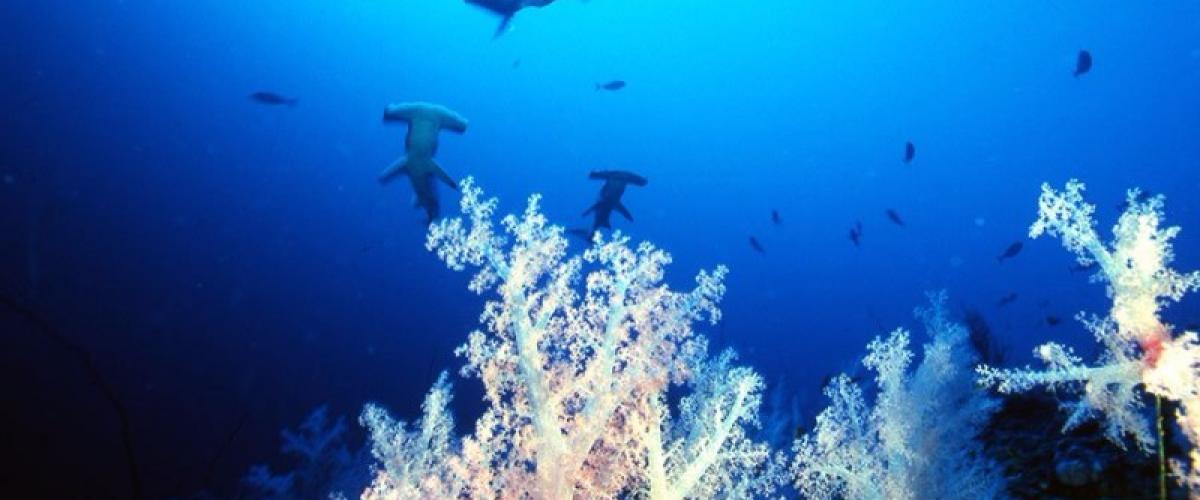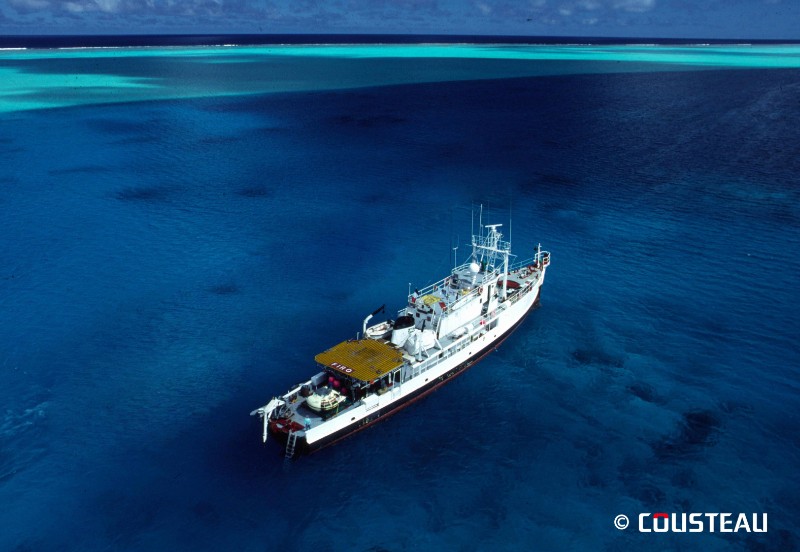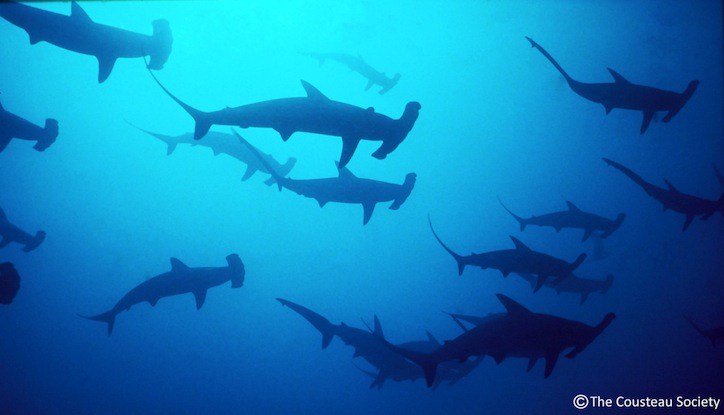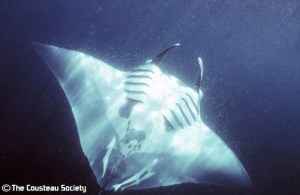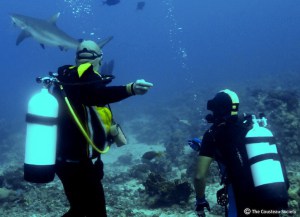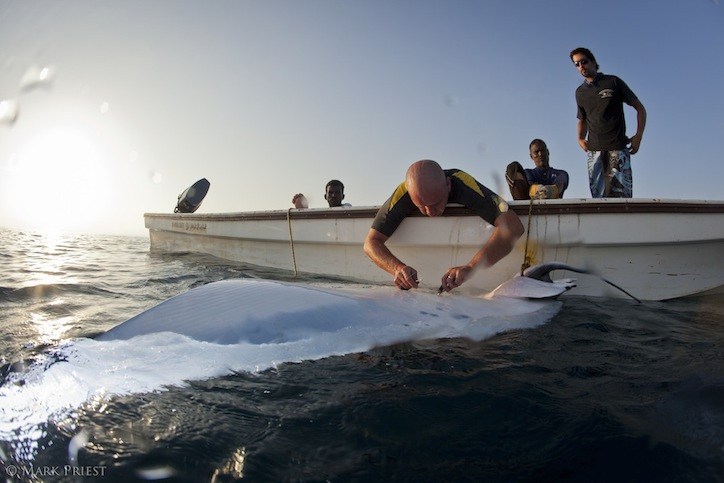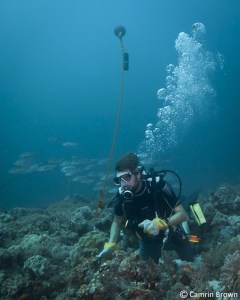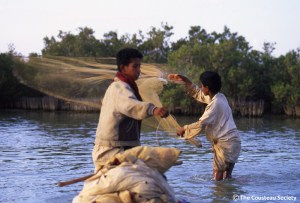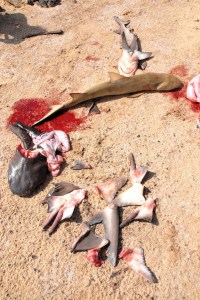Protect Sharks and Rays of The Red Sea
« We must not only defend sharks because they are useful and beautiful, but we must protect the sea that feeds them. And also restore the balance of the great ocean’s ecosystem, of which sharks form an important link and on which we ultimately depend. » JYC
As top predators, sharks play a vital role for maintaining the balance of our oceans. However, more than 90 millions of shark and ray are removed from the oceans each year, killed for their fins or caught as by-catch by fisheries targeting other species. There is an urgent need to protect them and the environment on which they depend!
At the present time, it is extremely rare to hear reports that shark populations are in good health. The Sudanese coast, in the Red Sea, remains one of the unique hotspots on earth where this statement holds true; specifically a large aggregation of manta rays within the pristine Dungonab Bay marine protected area and large schools of scalloped hammerheads sharks on nearly all the main offshore reefs.
Considering the reported collapse of shark populations around the world, why is this the case? Primarily, large-scale commercial fisheries have not been permitted or established in Sudanese waters and the Government of Sudan, in recognition of its unique natural marine heritage, drew up and implemented legislation for a complete ban on shark fishing and established two flagship National Marine Parks Sanganeb Atoll Marine National Park (SMNP) and Dungonab Bay-Mukkawar Island Marine National Park (DMNP), to help protect and sustainably manage its marine resources.
It is important not to understate that Sudan’s healthy shark populations remain under threat from human impacts and could face increasing pressures. Rapid declines in the numbers of these species could occur over a very short period of time. I we protect the local populations of sharks and rays in Sudan could contribute to rebuilt the entire Red Sea populations.
Cousteau is working in Sudan to build up the capacity of the Wildlife Conservation General Administration (WCGA), the national authority in charge of the marine protected areas, to actively protect their natural resources.
This multi-faceted program is a partnership between international and local organizations including WCGA, SUDIA – Sudanese Development Initiative, the University of Windsor, The Deep Aquarium in Hull, dive operators and other local stakeholders.
The program aims to:
- Build scientific knowledge and improve the conservation status of sharks and rays in the Red Sea;
- Engage the people who rely on and impact upon these species in the process by assisting local communities within the boundaries of DMNP to realise the potential benefits of protecting biodiversity through promotion and development of sustainable alternative livelihood programmes such as ecotourism;
- Build national capacity to effectively monitor and manage biodiversity of wide-ranging flagship species such as sharks and rays within the existing Marine Protected Areas and Sudan’s Red Sea.
Cousteau wish to especially thank the Deep Aquarium (www.thedeep.co.uk) and the Darwin Initiative (www.darwin.gov.uk) for their Financial support to this program.
Cousteau mainly rely on individual donors to develop and sustain its activities.
Monitoring and tracking program
- Participative science: the Divers Aware of Sharks project
Divers, often with their underwater cameras, regularly observe sharks and rays in their natural environment. If properly documented, these observations can be translated into hard data for scientific analysis and thus aid regional protection and sustainable management. Discussions with dive operators during a preliminary scoping study in October 2007 were extremely positive and resulted in the design and initiation of the project. Cousteau therefore undertakes a specific programme in collaboration with these important observers, who are able to collect required data on a daily basis.
Accordingly, Cousteau is pursuing the development of a sharks and rays monitoring program in collaboration with the recreational dive industry; the Diver Aware of Sharks project. To date, dive operators in Sudan have been collecting data since December 2007. This project has been set up to be adaptable for any global region, working towards a global Divers Aware of Sharks network.
The Divers Aware of Sharks project is an important component of the overall applied research program through contributing to and bolstering regular monitoring. The diver involvement enables daily monitoring of sharks and rays at key sites throughout the Sudan waters. Data collected on a regular basis is required to estimate species composition, abundance and variations in composition/abundance on any given reef over time. Throughout the diving season, organized diver reporting of sharks and rays observations include data on the species present, sex, estimated sizes, the numbers observed, and the depth/temperature of sightings during each dive. Photographic and video material is also archived to assist in identifying individual animals through mark or scar patterns and will aid in determining population structure.
- Tracking project:
By generating new scientific information about the migratory patterns of shark populations, our role is to assist national entities to take decisions based upon field knowledge.
By generating new scientific information about the migratory patterns of shark populations, our role is to assist national entities to take decisions based upon field knowledge.
In the first mission (October – November 2012), the scientific team, led by Dr Nigel Hussey and Dr Steven Kessel (University of Windsor – Canada) successfully tagged and released 22 manta rays (20 acoustic and 6 satellite tags), using for the first time ever in the world internal implantation of acoustic tags and dorsal fin attachments of satellite tags. Tagged manta rays are followed through an acoustic monitor array established during the mission directed by discussions with local fishermen, in Dungonab Bay and Mukkawar Marine Park as well as on all offshore reefs.
Satellite tags will allow the scientific team to track manta rays movements on a regional scale and genetic sampling of a large number of individuals will help to better understand species and population structure. To date, the satellite tagged manta rays have remained in a relatively small area within the boundaries of the Dungonab Marine Park, but have made larger movements to regions where they were not previously observed. This preliminary data suggest that Dungonab may be an effective Marine Park for the protection of this species. Genetic studies revealed a surprising result: the first record of a living hybrid of two distinct Manta species the Reef Manta Ray (Manta alfredi) and the Giant Manta (Manta birostris).
The team returned to the field to undertake the second mission (February 2013), and conduct wider survey on the reef ecosystem and food web. During a two weeks mission, the research team, led carried out state of the art research studies using a combination of techniques including acoustic tags and monitors, underwater fixed camera (BRUVS – Baited Remote Underwater Video Stations), biological sampling for food web work and visual surveys.
Tracking technologies used:
– Vemco acoustic monitor units with temperature loggers: Positioned at key sites along the Sudanese inshore/offshore reefs;
– Acoustic transmitters provide date, time, depth and temperature 24hrs/day, 365 days/year when the animal is present at monitoring site.
Animals are brought to the surface and basic measurements recorded including sex (clasper length), precaudal (PCL), fork (FL) and standard total length (TL) and a genetic sample are taken and stored.
Transmitters are inserted in the peritoneal body cavity and the incision closed with a single dissolvable suture following standard practices. A total work up time of 5-10 minutes per animal is anticipated which falls well within the stress tolerances of the target species.
Satellite tags are instrumental in identifying large-scale high-resolution movement/migrations of shark and ray species, providing detailed insights in to day-to-day depth and temperature profiles. They are attached externally.
Data from the project activities, including the identification of critical aggregation sites and migration routes (local and large scale movement patterns) in conjunction with environmental parameters will be integrated in to a GIS database to provide an effective conservation and management tool for regional monitoring and decision making.
Marine parks management and poverty alleviation
Sudan has designated two Marine Protected Areas, coastal and marine environments remain relatively pristine and the waters still host healthy populations of globally threatened elasmobranch species. This globally significant reservoir of biodiversity has yet to be internationally recognized and formal management established. Shark and rays are enigmatic flagship species with the potential to generate revenues for local communities through ecotourism and attract further investment in MPA management. The proposed project will improve knowledge about endangered/vulnerable elasmobranch species, build capacity to monitor, manage and support new nature-based livelihoods to help alleviate poverty.
The project aims at leading to the global recognition of Sudan as a marine biodiversity hotspot and raise awareness of the threatened status of sharks and rays. Knowledge of the movement/residency of data poor shark and ray species will inform both the preparation of spatial management plans within Sudan and the wider Red Sea region, and the development of sustainable ecotourism activities to assist communities inside the boundaries of DMNP (Dungonab and Mohammed Qol) to realise economic benefits from their marine biodiversity resources.
Management capacity will be strengthened through renovating infrastructure and training Wildlife Conservation General Administration staff to monitor biodiversity and MPA effectiveness, thereby ensuring Sudan is better equipped to manage its existing MPAs and threatened species. Training of national counterparts in scientific and participatory monitoring methods will promote stewardship, increase the long-term sustainability of monitoring programmes and likelihood that the results will inform adaptive management.
Community members inside DMNP will have access to microfinance thereby creating self-employment opportunities. First time beneficiaries will have exposure to loan processes and procedures and those with good repayment records will acquire opportunities for larger loans, allowing them to expand their business start-ups and increase their operating capital.
Stakeholder workshops will achieve a common future vision for the MPAs and participants will ‘own-up’ to reaching that desired future. Strengthening of resource management capacity will widen benefits to the Red Sea State, given the vast potential for scuba diving and international and national tourism.
More about Sharks and Rays
Sharks and rays…
… Vulnerable species:
Sharks and rays play an extremely important role in maintaining the balance and stability of our ocean’s ecosystems. Sharks are apex predators and contribute to the regulation of our coastal and pelagic foodwebs and influence all subsequent aspects of the marine ecosystem.
Sharks and rays are particularly vulnerable to fishing due to their:
Long lifespan: > 30 years, with some species reaching 100 years!
Late reproductive maturity (e.g 10 to 15 years for the scalloped hammerhead shark (Sphyrna lewini))
Low fecundity: a female shark produces few young per breeding season;
Long gestation period: from 7 months to 2 years
Due to these life history traits shark and ray populations typically grow slowly and are very slow to recover once depleted. Thus, almost 10% of elasmobranch species (sharks and rays) are on the IUCN Red List and are threatened to varying degrees by risk of extinction.
…. Facing high threats:
Modern research has documented the vast decline of many large shark species and raised global awareness of the threatened status of many other elasmobranch species and the need for management. This research has however also highlighted the frequent lack of information about the population status of most elasmobranch species at the national, regional and global level. Further research is therefore urgently needed to improve our understanding, particularly at a regional level (given the migratory nature of many elasmobranch species) if effective transboundary management and conservation strategies are to be developed.
Sharks and rays are targeted for both their meat and fins. The high demand and prices paid for shark fin in particular has resulted in a well developed global fishery which mostly operates illegally. Both sharks and particularly rays are also often caught accidentally by fisheries targeting other species, such as tuna. This incidental by-catch is discarded at sea. Globally, it is estimated that about 90 million sharks are removed each year from our oceans. The numbers of these incidental by-catches are often poorly recorded. So while the numbers of sharks and rays caught annually is alarming large, it is still certainly an under-estimate!
